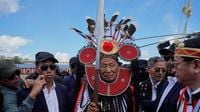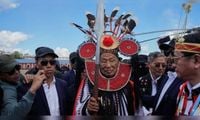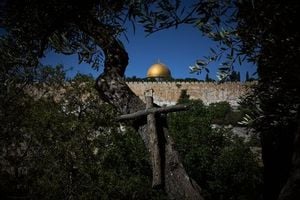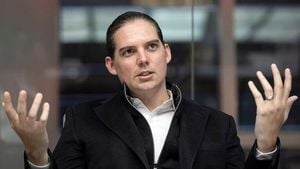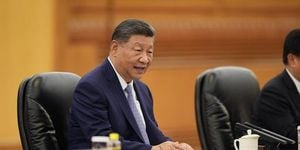On a crisp October morning in 2025, the usually quiet hills of Ukhrul district in Manipur, northeastern India, pulsed with anticipation. A helicopter, gleaming against the clear blue sky, descended slowly as thousands of people—men, women, and children—burst into cheers. The occasion? The long-awaited return of Thuingaleng Muivah, the 91-year-old leader of the National Socialist Council of Nagaland (Isak-Muivah), or NSCN (IM), to his hometown after more than five decades in exile.
According to the Associated Press, the excitement was palpable. Men and women donned traditional Naga attire, complete with feathered headgear and spears, forming a vibrant tableau of cultural pride. Schoolchildren lined the route, waving the iconic Naga flag—blue with a rainbow stretching across the center and a white star in the top left corner—an emblem of their enduring identity and aspirations.
Muivah, a towering figure in the region’s tumultuous history, left his home in Somdal village back in 1964 to join the Naga independence movement. Since then, he had only returned once, briefly, in 1973. His last attempt to visit in 2010 was thwarted by the Manipur state government, sparking deadly protests and leaving deep scars. This time, however, the homecoming was not just permitted—it was celebrated.
For many in Ukhrul and across Naga-inhabited areas, the sight of Muivah stepping onto his native soil was more than a personal milestone. It was a moment loaded with symbolism, hope, and, for some, a tinge of uncertainty. As reported by CNBC TV18, his arrival was greeted with “joy and celebration,” with thousands gathering to witness a piece of living history. The AP’s Anupam Nath captured the moment in a series of evocative photographs: Muivah embracing his wife, waving to the crowd, and being greeted by elders and children alike.
The roots of this extraordinary event stretch back to the 1950s, when the Naga insurgency erupted as a fight for an independent homeland for the Naga people—an Indigenous community spread across several northeastern Indian states. For decades, the movement was marked by both fierce armed struggle and painstaking political negotiations. Violence ebbed and flowed, but in 1997, a ceasefire was signed between the Indian government and NSCN (IM), ushering in a period of relative calm. Yet, as AP notes, a final settlement has remained elusive. Talks have repeatedly stalled, particularly over the NSCN (IM)’s demands for a separate Naga flag and constitution—symbols that, for many Nagas, represent the core of their political and cultural identity.
Muivah’s return comes at a delicate time for the peace process. As the current chief negotiator for the NSCN (IM), he has been leading discussions with India’s federal government, seeking greater political rights and autonomy for the Naga people. According to AP, “Muivah is currently leading peace talks with India’s federal government, seeking greater political rights for the Naga people, an Indigenous group spread across several northeastern Indian states.” The stakes are high—not just for Nagas, but for the broader stability of India’s northeast, a region long beset by ethnic tensions and separatist movements.
For many in the crowd, the day was about more than politics. It was about memory, belonging, and the power of home. As the helicopter touched down and Muivah emerged, the atmosphere was electric. Traditional dancers performed, elders offered blessings, and families snapped photographs to mark the occasion. Children, some perhaps too young to fully grasp the historical weight of the moment, waved their flags with infectious enthusiasm. The Associated Press video by Anupam Nath captured the cheers and the sea of waving flags, underscoring the sense of unity and pride that permeated the event.
Yet, beneath the celebration, there lingered the awareness of a long and complicated journey. The Naga struggle has been fraught with setbacks. The failed visit in 2010, which resulted in a ban and deadly protests, remains a fresh memory for many. The peace talks, while ongoing, have not yet produced the breakthrough that many hope for. The demand for a separate flag and constitution remains a sticking point, with the Indian government wary of setting precedents that could embolden other separatist movements.
Still, for the Nagas, Muivah’s homecoming was a reminder of their resilience and their determination to shape their own future. As reported by CNBC TV18, “Muivah’s return to Ukhrul, therefore, carries both symbolic and political significance—seen as a reminder of the long and complex path towards lasting peace in the region.” The presence of armed cadres from NSCN (IM), standing guard as the festivities unfolded, was a subtle reminder that the struggle is not yet over.
For Muivah himself, the day must have been bittersweet. After decades spent away from his homeland—years marked by conflict, negotiation, and personal sacrifice—he was finally able to embrace his roots. The photographs of him greeting old friends, embracing his wife, and waving to the crowds spoke volumes about the emotional weight of the moment.
The broader significance of this event was not lost on observers. The Naga movement, while unique in its specifics, echoes the struggles of Indigenous and minority groups around the world seeking recognition, rights, and a place in the national narrative. The AP highlighted that “violence has waned since a 1997 ceasefire between India and Muivah’s group, the National Socialist Council of Nagaland (Isak-Muivah), but talks remain stalled over demands for a separate flag and constitution.” The hope now is that gestures like Muivah’s return can help bridge divides and foster a renewed spirit of dialogue.
As the celebrations in Ukhrul wound down, the questions that have long haunted the Naga issue remained unresolved. Will the peace talks finally bear fruit? Can the aspirations of the Naga people be reconciled with the imperatives of the Indian state? Only time will tell. But for one day, at least, the hills of Manipur echoed with cheers, music, and the flutter of blue flags—a testament to the enduring power of homecoming and the unbroken thread of hope.
As dusk settled over Ukhrul, the memory of Muivah’s return lingered in the air—a reminder that, even after decades of conflict and exile, the bonds of community and identity can still draw a people together in celebration and resolve.
